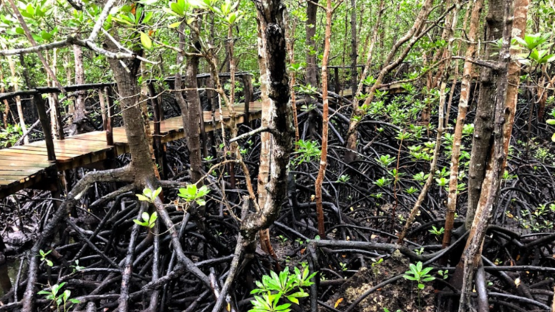Absorbing almost a quarter of all human-made carbon dioxide (CO2) gas emitted into the atmosphere each year, the ocean is both a victim of, and a solution to, climate change. On one hand, the excessive CO2 changes its chemistry, leading to ocean acidification, which can have lasting effects on the health of marine organisms and ecosystems. On the other, exactly because of this absorption, the ocean may be one of humanity’s key tools in both mitigation and adaptation efforts.
This was the focus of yesterday’s IAEA event at the #Atoms4Climate Pavilion during the 27th Conference of the Parties (COP27) to the United Nations Framework Convention on Climate Change (UNFCCC) in Sharm El-Sheikh, Egypt. In a roundtable discussion, marine science experts discussed the role of the ocean in providing a long term, nature-based solution to reducing CO2 concentrations in the atmosphere – through carbon that can be stored long term in the soils and vegetation of marine ecosystems, such as mangrove forests, salt marshes and seagrass meadows – known as Blue Carbon.
The event covered the need for research and development in the field of Blue Carbon specifically, and the importance of preserving the vegetated coastal ecosystems that remain. Panelist Dr Ana Querios of Plymouth Marine Laboratory in the UK, said: “Facing both a climate change emergency and a biodiversity crisis, it is our job to make sure we fully understand the ability of the ocean to help mitigate each of these issues, and to support the development of solutions that protect it.”
Each panelist stressed the need for swift action and more in-depth research, as well as the vulnerability of vegetated coastal ecosystems to destruction. Professor Jean-Pierre Gattuso of the CNRS, IDDRI and Sorbonne Université in France, highlighted that while the climactic benefits of coastal Blue Carbon ecosystems are uncertain, “the conservation and restoration of these ecosystems are nevertheless absolutely essential to maintain or recover the numerous services they provide for coastal protection, food security and biodiversity.”
Blue Carbon and carbon sequestration have significant potential to be used strategically as a long term solution to increasing CO2 emissions. However, this requires the exact capacity of Blue Carbon and Blue Carbon habitats to be defined.
As part of its commitment to the United Nations Sustainable Development Goal 14, which aims to “conserve and sustainably use the oceans, seas and marine resources for sustainable development,” the IAEA uses nuclear technology and applications to help countries tackle the impacts of climate change. Using natural and artificial radionuclides to measure the rates and origin of sediment accumulation, the IAEA can determine accurate carbon storage rates – known as carbon sequestration – in vegetated coastal areas, allowing policymakers and scientists to determine which Blue Carbon habitats are more efficient carbon sinks.
The IAEA is involved in Blue Carbon projects in more than 30 countries to assess the rates of carbon sequestration in vegetated coastal areas and to aid in data collection. On the African continent alone, the IAEA is working with 12 countries to build capacity on Blue Carbon. Through this regional technical cooperation project, the IAEA is training scientists and assists with the establishment of laboratories with the capability to accurately measure carbon sequestration rates.
“At the IAEA’s Marine Environment Laboratories in Monaco, we are investigating the potential of coastal vegetative ecosystems as natural climate solutions to increase the drawdown of CO2 from the atmosphere and long-term storage of CO2 in the sediment,” said Jana Friedrich, Head of the IAEA Radioecology Laboratory.
Why Blue Carbon?
Professor Carlos M. Duarte of King Abdullah University of Science and Technology in Saudi Arabia, emphasized the varied benefits of Blue Carbon. “Carbon removal using Blue Carbon ecosystems is cost effective, safe and generates a wealth of co-benefits aiding in the adaptation of the receiving communities,” he said.
Blue Carbon is stored in both coastal and open marine ecosystems. It refers to the process by which healthy vegetated ecosystems take up, or absorb, carbon, reducing the overall amount of CO2 in the atmosphere. At the same time, mangrove forests for example, serve as coastal protection against sea level rise and extreme events.
Ocean carbon sequestration is of particular interest, as unlike land-based forms of carbon sequestration, Blue Carbon ecosystems can bury carbon in sediment for long periods of time, sometimes centuries or even millennia. It is for this reason that Blue Carbon ecosystems, specifically ecosystems that accumulate sediment, are of such relevance in efforts to reduce CO2 in the atmosphere.
In addition to their utility of taking up carbon, seagrass meadows, mangrove forests and salt marshes, for example, all act as stabilizers, and thereby keep sediment from being disturbed. Once carbon is sequestered, therefore, it will remain there, avoiding the remineralization of carbon and the subsequent release of CO2. This is why preserving and protecting these ecosystems is so critical – the CO2 they are sequestering would be released if the sediment is disturbed.




